CHAPTER XI.
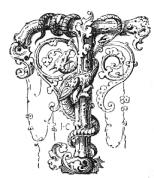
HE house at Newburgh, which was occupied by Washington,
was built by Jonathan Hasbrouck, in 1750, and is known by the respective names
of "Hasbrouck House" and "Washington Headquarters." It
has been the property of the State for several years, and a sufficient annual
appropriation from the State treasury is made, to keep it, with the grounds
around, in good order. Within it are collected many relies of the revolution,
the war of 1812-15, and the war with Mexico.
In connection with this house, as the head-quarters of the army,
occurred one of the most interesting events in the life of Washington, to
which allusion has already been made. It was in the spring of 1783. Peace
had been declared, a preliminary treaty had been signed by Great Britain and
the United States, and the Continental Army was soon to be disbanded. The
civil confederacy was weak. For a long time the Congress had been unable to
pay the army, and officers and soldiers were likely to be sent home penniless,
large pecuniary creditors of the country whose independence they had achieved.
Secret consultations were held among a few of the officers. They had lost
faith in the Congress, and began to doubt the feasibility of republican government,
and some of them indirectly offered the power and title of King to Washington.
He spurned the proposition with indignation. Then an appeal to the officers
of the army was written, and secretly disseminated, in which grievances were
set forth, and they were advised to take matters into their own hands, and,
in effect, form a military despotism if the Congress should not speedily provide
for their pay. Washington was informed of the movement. He resolved to control,
without seeming to oppose it. He called a meeting of the officers, and the
suspected ringleader of the movement was asked to preside. When all were assembled,
Washington stopped forward and read to them a powerful appeal to their patriotism.
His first words, before unfolding the paper, touched every heart. "You
see, gentlemen," he said, as he placed his spectacles before his eyes,
"that I have grown not only grey, but blind, in your service." His
address, as usual, was short, pointed, convincing, and most persuasive. All
eyes were filled with tears. The spirit 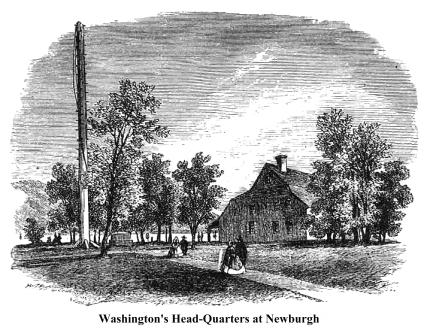 of
mutiny and revolt shrank abashed, and the assembly resolved unanimously, "That
the officers of the American army view with abhorrence, and reject with disdain,
the infamous propositions contained in a late anonymous address to the officers
of the army." This scene did not occur at head-quarters, but in a large
temporary building a few miles in the interior, near where the army lay at
that time.
of
mutiny and revolt shrank abashed, and the assembly resolved unanimously, "That
the officers of the American army view with abhorrence, and reject with disdain,
the infamous propositions contained in a late anonymous address to the officers
of the army." This scene did not occur at head-quarters, but in a large
temporary building a few miles in the interior, near where the army lay at
that time.
In the centre of the Hasbrouck House, or Head-quarters, is
a large hall, having on one side an enormous fire-place, and containing seven
doors, but only one window. Here Washington received his friends; here large
companies dined; and here, from time to time, some of the most distinguished
characters of the revolution, civil and military, were assembled. Colonel
Nicholas Fish, of the Continental Army, used to relate an interesting fact
connected with this room. He was in Paris a short time before the death of
the Marquis de Lafayette, who had lodged many nights beneath the roof of the
"Hasbrouck House." Colonel Fish was invited, with the American minister,
on one occasion, to sup at the house of the distinguished Marbois, who was
the French Secretary of Legation in the United States during the revolution.
Lafayette was one of the guests. At the supper hour the company 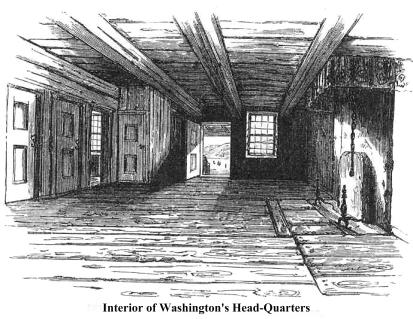 was
shown into a room which contrasted quite oddly with the Parisian elegance
of the other apartments, where they had spent the evening. A low, boarded,
painted ceiling, with large beams, a single small, uncurtained window, with
numerous small doors, as well as the general style of the whole, gave, at
first, the idea of the kitchen, or largest room, of a Dutch or Belgian farm-house.
On a long rough table was a repast, just as little in keeping with the refined
cuisines of Paris, as the room was with its architecture. It consisted of
a large dish of meat, uncouth-looking pastry, and wine in decanters and bottles,
accompanied by glasses and silver mugs, such as indicated other habits and
tastes than those of modern Paris. "Do you know where we now are?"
said Marbois to Lafayette and his American companions. They paused in surprise
for a few minutes. They had seen something like it before, but when? and where?
"Ah! the seven doors and one window," exclaimed Lafayette, "and
the silver camp-goblets, such as the Marshals of France used in my youth!
We are at Washington's Head-quarters, on the Hudson, fifty years ago!"
was
shown into a room which contrasted quite oddly with the Parisian elegance
of the other apartments, where they had spent the evening. A low, boarded,
painted ceiling, with large beams, a single small, uncurtained window, with
numerous small doors, as well as the general style of the whole, gave, at
first, the idea of the kitchen, or largest room, of a Dutch or Belgian farm-house.
On a long rough table was a repast, just as little in keeping with the refined
cuisines of Paris, as the room was with its architecture. It consisted of
a large dish of meat, uncouth-looking pastry, and wine in decanters and bottles,
accompanied by glasses and silver mugs, such as indicated other habits and
tastes than those of modern Paris. "Do you know where we now are?"
said Marbois to Lafayette and his American companions. They paused in surprise
for a few minutes. They had seen something like it before, but when? and where?
"Ah! the seven doors and one window," exclaimed Lafayette, "and
the silver camp-goblets, such as the Marshals of France used in my youth!
We are at Washington's Head-quarters, on the Hudson, fifty years ago!"
Upon the lawn, a little eastward of the Head-quarters, is a
tall flag-staff, and near it a chaste monument, 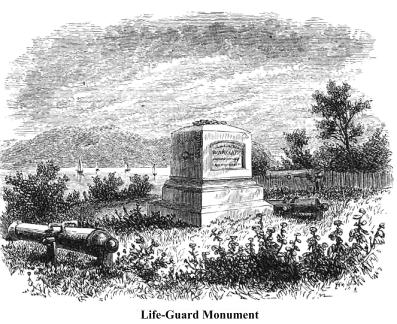 in
the form of a mausoleum, made of brown sandstone, and erected early in the
summer of 1860, over the grave of the latest survivor of Washington's life-guard.
The monument was dedicated on the 18th of June, with appropriate services
in connection with a large civic and military parade. It is about six feet
in height, and is surmounted by a large recumbent wreath. On the river-front
are the words:--" THE LAST OF THE LIFE GUARDS. UZAL KNAPP, BORN, 1759;
DIED, 1856. MONMOUTH, VALLEY FORGE, YORKTOWN. " On the opposite side:--"
ERECTED BY THE NEWBURGH GUARDS, COMPANY F., 19TH REGIMENT, N.Y.S.M., JUNE,
1860." It is surrounded by a chain supported by granite posts, and is
flanked by two pieces of heavy cannon. The monument was designed by H.K. Brown,
the sculptor.
in
the form of a mausoleum, made of brown sandstone, and erected early in the
summer of 1860, over the grave of the latest survivor of Washington's life-guard.
The monument was dedicated on the 18th of June, with appropriate services
in connection with a large civic and military parade. It is about six feet
in height, and is surmounted by a large recumbent wreath. On the river-front
are the words:--" THE LAST OF THE LIFE GUARDS. UZAL KNAPP, BORN, 1759;
DIED, 1856. MONMOUTH, VALLEY FORGE, YORKTOWN. " On the opposite side:--"
ERECTED BY THE NEWBURGH GUARDS, COMPANY F., 19TH REGIMENT, N.Y.S.M., JUNE,
1860." It is surrounded by a chain supported by granite posts, and is
flanked by two pieces of heavy cannon. The monument was designed by H.K. Brown,
the sculptor.
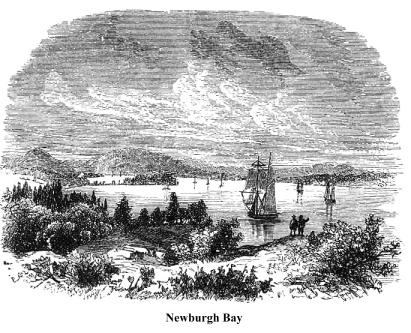 Mr.
Knapp, the recipient of these honours, was, for a long time, the only surviving
member of the body-guard of Washington, which was organized at Boston in the
spring of 1776, and continued throughout the war. They were selected from
all the regiments of the Continental Army, and chosen for their peculiar fitness
of person and moral character. Mr. Knapp was a sergeant of the Guard, and
was presented by Washington with a badge of Military Merit--the American Legion
of Honour. In the autumn of 1855, the writer was at a public dinner where
the old guardsman was a guest. He was then almost ninety-six years of age.
When he was about to leave the table, the company arose. The veteran addressed
a few words to them, and concluded by inviting them all to his funeral! Just
four months afterwards he died, and many who were at the feast were at the
burial. By permission of his family, the citizens of Newburgh, after his body
had lain in state for three days, buried him at the foot of the flag-staff,
near the old head-quarters of his chief, where he had watched and sported
three-quarters of a century before. It was over that grave the monument we
have delineated was recently erected.
Mr.
Knapp, the recipient of these honours, was, for a long time, the only surviving
member of the body-guard of Washington, which was organized at Boston in the
spring of 1776, and continued throughout the war. They were selected from
all the regiments of the Continental Army, and chosen for their peculiar fitness
of person and moral character. Mr. Knapp was a sergeant of the Guard, and
was presented by Washington with a badge of Military Merit--the American Legion
of Honour. In the autumn of 1855, the writer was at a public dinner where
the old guardsman was a guest. He was then almost ninety-six years of age.
When he was about to leave the table, the company arose. The veteran addressed
a few words to them, and concluded by inviting them all to his funeral! Just
four months afterwards he died, and many who were at the feast were at the
burial. By permission of his family, the citizens of Newburgh, after his body
had lain in state for three days, buried him at the foot of the flag-staff,
near the old head-quarters of his chief, where he had watched and sported
three-quarters of a century before. It was over that grave the monument we
have delineated was recently erected.
The natural scenery around Newburgh has an aspect of mingled
grandeur and beauty, peculiar and 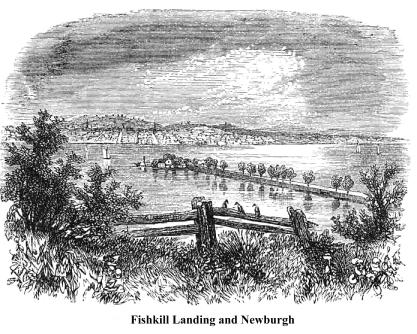 unrivalled.
Before the town is the lofty range of the Fishkill Mountains, on which signal
fires were lighted during the revolution; and the group of the Highlands,
through which the Hudson flows. These are reflected in a broad and beautiful
bay, at all times animated with a variety of water-craft and wild-fowl. Even
in winter, when the frost has bridged the entire river, Newburgh Bay presents
a lively scene almost every day, for ice-boats and skaters are there in great
abundance. Its broad surface is broken by only a solitary rock island. One
of the finest and most comprehensive views of Newburgh Bay may be obtained
from the hill, just below the Fishkill and Newburgh railway-station, looking
south-west. This view is given in our sketch. It includes the lower part of
Newburgh, the mouth of the Quassaic Creek, the villages of New Windsor, and
Cornwall, the beautiful low peninsula called Denning's Point on the left,
and the higher one of Plum Point, on the western shore, seen in the centre.
Just beyond the latter is the mouth of the Moodna, a fine clear stream that
comes down from the hill-country of Orange County. The view is bounded on
the left by the lofty hills extending westward from the Storm King, at whose
base the Hudson enters the Highlands.
unrivalled.
Before the town is the lofty range of the Fishkill Mountains, on which signal
fires were lighted during the revolution; and the group of the Highlands,
through which the Hudson flows. These are reflected in a broad and beautiful
bay, at all times animated with a variety of water-craft and wild-fowl. Even
in winter, when the frost has bridged the entire river, Newburgh Bay presents
a lively scene almost every day, for ice-boats and skaters are there in great
abundance. Its broad surface is broken by only a solitary rock island. One
of the finest and most comprehensive views of Newburgh Bay may be obtained
from the hill, just below the Fishkill and Newburgh railway-station, looking
south-west. This view is given in our sketch. It includes the lower part of
Newburgh, the mouth of the Quassaic Creek, the villages of New Windsor, and
Cornwall, the beautiful low peninsula called Denning's Point on the left,
and the higher one of Plum Point, on the western shore, seen in the centre.
Just beyond the latter is the mouth of the Moodna, a fine clear stream that
comes down from the hill-country of Orange County. The view is bounded on
the left by the lofty hills extending westward from the Storm King, at whose
base the Hudson enters the Highlands.
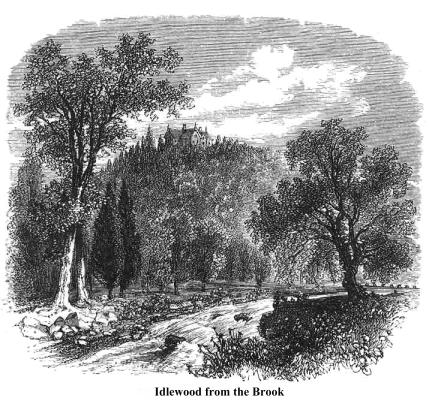 At
Newburgh is the eastern terminus of a branch of the New York and Eric Railway,
which passes through some of the most picturesque scenery in the world, between
the Hudson and Delaware rivers. In the vicinity of the village are charming
drives, but no one is more attractive towards evening, than that along the
river-bank, through New Windsor to Idlewild, the residence of the well-known
author, N.P. Willis, Esq. I traveled that road on a hot afternoon in August.
The shadows were short; a soft breeze came up the river from the open northern
door of the Highlands, whose rugged forms were bathed in golden light. On
the land not a leaf was stirred by a zephyr. I crossed the Moodna, in whose
shallow waters the cattle were seeking cool retreats, and I was glad to take
shelter from the hot sun in the shadows of the old trees on the margin of
the brook that rushes from the Glen at Idlewild. There all was cool, quiet,
and delightful. The merry laugh of children came ringing like the tones of
silver bells through the open grove. I sat down
At
Newburgh is the eastern terminus of a branch of the New York and Eric Railway,
which passes through some of the most picturesque scenery in the world, between
the Hudson and Delaware rivers. In the vicinity of the village are charming
drives, but no one is more attractive towards evening, than that along the
river-bank, through New Windsor to Idlewild, the residence of the well-known
author, N.P. Willis, Esq. I traveled that road on a hot afternoon in August.
The shadows were short; a soft breeze came up the river from the open northern
door of the Highlands, whose rugged forms were bathed in golden light. On
the land not a leaf was stirred by a zephyr. I crossed the Moodna, in whose
shallow waters the cattle were seeking cool retreats, and I was glad to take
shelter from the hot sun in the shadows of the old trees on the margin of
the brook that rushes from the Glen at Idlewild. There all was cool, quiet,
and delightful. The merry laugh of children came ringing like the tones of
silver bells through the open grove. I sat down 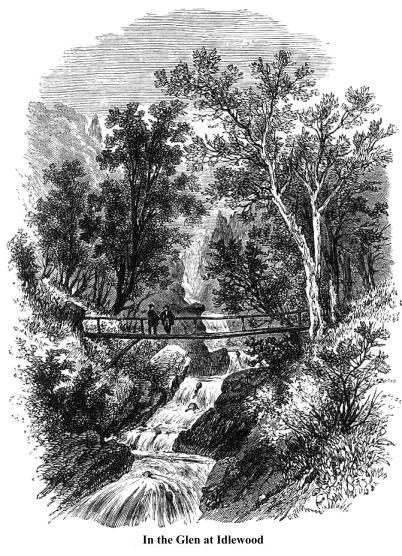 upon the bank of the brook, to enjoy the sweet repose of the scene, when,
looking up, the cottage of Idlewild, half concealed by evergreens, stood in
full view on the brow of the glen, two hundred feet above me. The whole acclivity
is covered with the primeval wood, which presents an apparently impenetrable
barrier to approach from below.
upon the bank of the brook, to enjoy the sweet repose of the scene, when,
looking up, the cottage of Idlewild, half concealed by evergreens, stood in
full view on the brow of the glen, two hundred feet above me. The whole acclivity
is covered with the primeval wood, which presents an apparently impenetrable
barrier to approach from below.
After sketching the attractive scene, I went leisurely up the deep, cool, dark glen, to its narrowest point, where the brook occupies the whole bottom of the gorge, and flows in picturesque rapids and cascades over and, among rugged rocks and overhunging trees and shrubbery, with a rustic foot-bridge, the solitary testimony that man had ever penetrated that wild retreat.
A winding pathway lead from the slender bridge in the glen up to the cottage of Idlewild, which is at the north-eastern angle of the Highland Terrace, on which the village of Cornwall stands. The views from it are exceedingly beautiful. From the southern porch a lawn rises gently, beyond which nothing can be seen but the purple sides and summit of the Storm King, rising nearly 1,600 feet above the river. A little way from the cottage, a full view of Newburgh Bay and the river and country above may be obtained; and on the left, the placid estuary into which the Moodna* flows, reflects all the glories of sunset.
* This was called Murderer's Creek, because, in early times, with a family of white people, who lived upon its banks, was murdered by the Indians. Mr. Willis, with a laudable desire to get rid of a name so unpleasant, sought reasons for establishing the belief that it is a corruption of the sweet Indian word Moodna. He has been successful, and the stream is now generally called Moodna's Creek. Such is also the name of the post-office there, established by the government. It is to be hoped that the old name will be speedily forgotten.
The Highland Terrace owes its name and fame to Mr. Willis, whose pen has been as potent as the wand of a magician in peopling that delightful spot with summer residents from New York. He has thoroughly "written it up." It is a fertile strip of land, quite elevated, lying at the foot of the north-western slopes of the mountains. The grape is cultivated there with success; and as its banks yield some of the finest brick clay in the country, it has become a celebrated brick-making place. Cornwall Landing is at the base of the Terrace near the foot of the Storm King, and is reached from the plateau by a steep, winding road. During the summer months it exhibits gay scenes at the hours when the steamboats arrive. Many of the temporary residents of that vicinity have their own carriages, and these, filled with pleasure-seeking people, expecting to meet friends, or only hoping to see new faces, quite cover the wharf at times, especially at evening.
Copyright © 1998, -- 2004. Berry Enterprises. All rights reserved. All items on the site are copyrighted. While we welcome you to use the information provided on this web site by copying it, or downloading it; this information is copyrighted and not to be reproduced for distribution, sale, or profit.